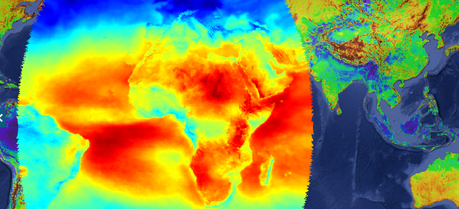 Africa solar irradiation map based on the HelioClim-1 database. (Credit: IRENA)
Africa solar irradiation map based on the HelioClim-1 database. (Credit: IRENA)
A new article (see footnote) by the Joint Research Center (JRC), the EU in-house scientific service, seems to confirm that the solution to the Africa’s energy problems lies with renewable energy sources. For instance, calculations show that solar panels is the cheapest electricity source for 34% of the overall African population.
A geo-economic analysis, identifying the least-cost rural electrification options for sub-Saharan Africa which could bring an end to the persistent energy poverty, was recently presented in an article published in Renewable and Sustainable Energy Reviews. JRC scientists carried out their research in collaboration with colleagues from the United Nations Environment Program (UNEP).
For each geographical location, calculated for each km2 pixel, the lowest cost options for electricity generation via mini hydropower (with a capacity ranging from 100 kW to 1 MW), photovoltaic (PV) solar panels which are not connected to the power network and diesel generators are calculated and then they are compared to the costs for an extension of the electricity grid.
Calculations showed for example that in 2012 PV was the cheapest electricity source for 34% of the overall African population. The grid extension costs differed depending on the distance from the grid, but an additional 2,5 eurocents/kW·h per km had to be accounted for.
The energy-related local data and regional geo-information is organized in user-friendly maps, which could help decision- and policy-makers to plan the least-cost rural electrification scenarios, thereby also reducing the energy poverty gap.
The energy technologies mentioned above have gone through fundamental changes, leading to cost reductions and making them more competitive. PV modules, for instance, now cost ten times less than in 2000.
The research is mainly based on findings by the JRC’s African Renewable Energy Technology Platform (AFRETEP) and contributes to the United Nations’ initiative Sustainable Energy for All (SE4ALL). Sharing this geo-information can also be marked as a milestone in the JRC’s collaboration with the International Renewable Energy Agency (IRENA) and the ECOWAS Center for Renewable Energy and Energy Efficiency (ECREEE). Indeed, the data incorporated in these maps can now be shown as reviewed maps in IRENA’s and ECREEE’s map catalogs and map servers.
S. Szabóa, K. Bódisa, T. Hulda, M. Moner-Girona (2013). Sustainable energy planning: Leapfrogging the energy poverty gap in Africa Renewable and Sustainable Energy Reviews, 28, 500-509 DOI: 10.1016/j.rser.2013.08.044
